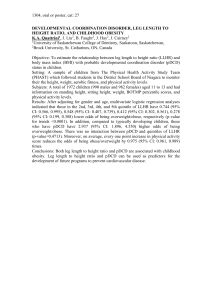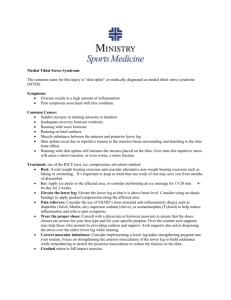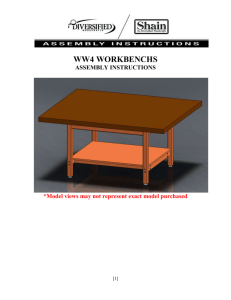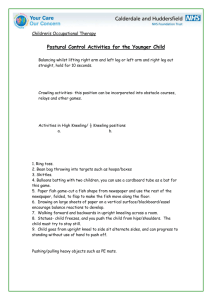North Star Ambulatory Assessment
advertisement
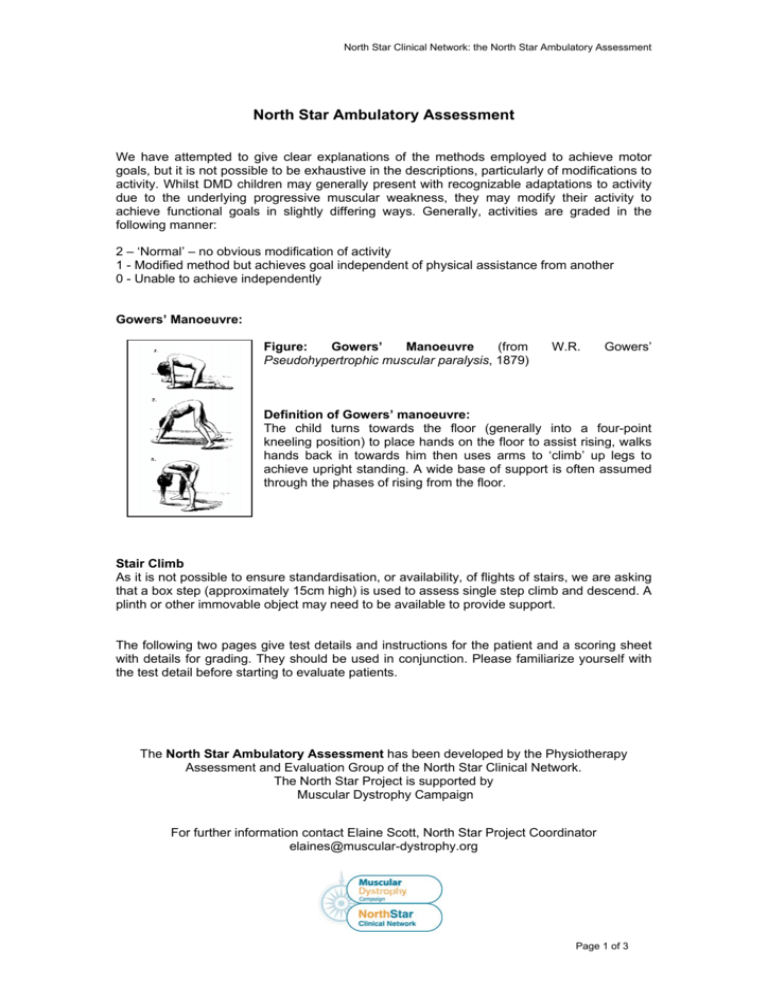
North Star Clinical Network: the North Star Ambulatory Assessment North Star Ambulatory Assessment We have attempted to give clear explanations of the methods employed to achieve motor goals, but it is not possible to be exhaustive in the descriptions, particularly of modifications to activity. Whilst DMD children may generally present with recognizable adaptations to activity due to the underlying progressive muscular weakness, they may modify their activity to achieve functional goals in slightly differing ways. Generally, activities are graded in the following manner: 2 – ‘Normal’ – no obvious modification of activity 1 - Modified method but achieves goal independent of physical assistance from another 0 - Unable to achieve independently Gowers’ Manoeuvre: Figure: Gowers’ Manoeuvre (from Pseudohypertrophic muscular paralysis, 1879) W.R. Gowers’ Definition of Gowers’ manoeuvre: The child turns towards the floor (generally into a four-point kneeling position) to place hands on the floor to assist rising, walks hands back in towards him then uses arms to ‘climb’ up legs to achieve upright standing. A wide base of support is often assumed through the phases of rising from the floor. Stair Climb As it is not possible to ensure standardisation, or availability, of flights of stairs, we are asking that a box step (approximately 15cm high) is used to assess single step climb and descend. A plinth or other immovable object may need to be available to provide support. The following two pages give test details and instructions for the patient and a scoring sheet with details for grading. They should be used in conjunction. Please familiarize yourself with the test detail before starting to evaluate patients. The North Star Ambulatory Assessment has been developed by the Physiotherapy Assessment and Evaluation Group of the North Star Clinical Network. The North Star Project is supported by Muscular Dystrophy Campaign For further information contact Elaine Scott, North Star Project Coordinator elaines@muscular-dystrophy.org Page 1 of 3 North Star Clinical Network: the North Star Ambulatory Assessment Test Detail and Instructions to Patient Instructions to patient Start position/test detail 1. Stand Can you stand up tall for me for as long as you can and as still as you can Feet should be close together and heels on the ground if possible. Arms by sides. NO shoes should be worn. 2. Walk Can you walk from A to B (state to and where from) for me. Walk without shoes/socks on. Should be enough of a distance to observe ‘normal gait’ for that subject 3. Stand up from chair Stand up from the chair keeping your arms folded if you can Starting position 90º hips and knees, feet on floor/supported on a box step. Activity 4. Stand on one leg Right 5. Stand on one leg Left 6. Climb box step right 7. Climb box step left 8. Descend box step Right 9. Descend box step Left 10. Gets to sitting 11. Rise from floor Can you stand on your right leg for as long as you can? Can you stand on your left leg for as long as you can? Can you step onto the top of the box using your right leg first? Can you step onto the top of the box using your left leg first? Can you step down from the box using your right leg first? Minimum count of 3 seconds to score 2. NO shoes should be worn. Minimum count of 3 seconds to score 2. NO shoes should be worn. Stands facing the box step. Step should be approximately 15cm high Stands facing the box step. Step should be approximately 15cm high Stands on top of the box step facing forwards. Step should be approximately 15cm high Stands on top of the box step facing forwards. Step should be approximately 15cm high Can you get from lying to sitting? Starting position supine on a mat. No pillow should be used under head If patient turns into prone or towards the floor to work their way into sitting 1 should be scored Get up from the floor using as little support as possible and as fast as you can (from supine) Starting position supine with arms by sides, legs straight. No pillow to be used Activity should be attempted without use of furniture in the first instance. Do not note time if a chair has to be used. 12. Lifts head Supine on a mat. No pillow should be used. 13. Stands on heels Can you stand on your heels? Standing on the floor. No shoes to be worn. How high can you jump? Standing on the floor, feet fairly close together. Can you hop on your right leg? Can you hop on your left leg? Starting position standing on floor on right leg. No shoes should be worn. Starting position standing on floor on right leg. No shoes should be worn. A straight 10m walkway should be clearly marked in a quiet department or corridor. A stopwatch should be used to time the walk. Be consistent as to whether shoes are worn or not. Ensure safety of patient. They should self select speed after being asked to go ‘as fast as they can’. 15. Hop right leg 16. Hop left leg 17. Run (10m) Best done on the floor rather than on a mat. Whichever is chosen maintain consistency through repeated testing sessions. Minimum count of 3 seconds to score 2. A value judgement needs to be made in scoring – if the patient generally toe walks but occasionally gets heels flat, or can on request but doesn’t usually, they should score 1 A size-appropriate chair or height adjustable plinth should be used. Arms should be kept crossed throughout the activity to score 2. Best done on the floor rather than on a mat. Whichever is chosen maintain consistency through repeated testing sessions. Best done on the floor rather than on a mat. Whichever is chosen maintain consistency through repeated testing sessions. Support may be provided by the use of a height adjustable plinth, or, if not available a ‘neutral’ hand from the therapist. Support may be provided by the use of a height adjustable plinth, or, if not available a ‘neutral’ hand from the therapist. Support may be provided by the use of a height adjustable plinth, or, if not available a ‘neutral’ hand from the therapist. Support may be provided by the use of a height adjustable plinth, or, if not available a ‘neutral’ hand from the therapist. Can you step down from the box using your left leg first? Lift your head to look at your toes keeping your arms folded 14. Jump Comments Run as fast you can to……(give point) Ask patient to keep arms crossed over chest during the activity to avoid self-assist. Also ask to look at toes to ensure neck is flexed – should be a chin to chest manoeuvre. Watch for inversion. If substantial inversion but forefeet are still lifted – score 1. If only inversion with lateral border of foot still on the ground score 0. Want height, not forward movement. Small amount of forward movement acceptable Needs obvious floor clearance to score 2 Needs obvious floor clearance to score 2 ‘Duchenne jog’ - not a true run (there probably IS a double support phase), but more than a walk. Typically characterized by excessive use of arms, trunk rotation, substantial ’waddle’. No real ‘pushoff’ Page 2 of 3 North Star Clinical Network: the North Star Ambulatory Assessment North Star Ambulatory Assessment – Score Sheet 2 1 Stands upright, still and symmetrically, without compensation (with heels flat and legs in neutral) for minimum count of 3 seconds Stands still but with some degree of compensation (e.g. on toes or with legs abducted or with bottom stuck out) for minimum count of 3 seconds Cannot stand still or independently, needs support (even minimal) 2. Walk Walks with heel-toe or flat-footed gait pattern Persistent or habitual toe walker, unable to heel-toe consistently Loss of independent ambulation – may use KAFOs or walk short distances with assistance 3. Stand up from chair Keeping arms folded Starting position 90º hips and knees, feet on floor/supported on a box step. With help from thighs or push on chair or prone turn Unable 4. Stand on one leg - right Able to stand in a relaxed manner (no fixation) for count of 3 seconds 5. Stand on one leg - left Able to stand in a relaxed manner (no fixation) for count of 3 seconds Activity 1. Stand 6. Climb box step - right 7. Climb box step - left 8. Descend box step right 9. Descend box step -left 10. Gets to sitting 11. Rise from floor 12. Lifts head 13. Stands on heels 14. Jump 15. Hop right leg 16. Hop left leg 17. Run (10m) Faces step – no support needed Faces step – no support needed Faces forward, climbs down controlling weight bearing leg. No support needed Faces forward, climbs down controlling weight bearing leg. No support needed Stands but either momentarily or needs a lot of fixation e.g. by knees tightly adducted or other trick Stands but either momentarily or needs a lot of fixation e.g. by knees tightly adducted or other trick Goes up sideways or needs support Goes up sideways or needs support 0 Unable Unable Unable Unable Sideways, skips down or needs support Unable Sideways, skips down or needs support Unable Starts in supine – may use one hand to assist Self assistance e.g. – pulls on legs or uses head-onhands or head flexed to floor Unable From supine – no evidence of Gowers’ manoeuvre* Gowers’ evident (a) NEEDS to use external support object e.g. chair OR (b) Unable Head is lifted but through side flexion or with no neck flexion Unable Flexes hip and only raises forefoot Unable One foot after the other (skip) Unable In supine, head must be lifted in mid-line. Chin moves towards chest Both feet at the same time, clearly standing on heels only (acceptable to move a few steps to keep balance) for count of 3 Both feet at the same time, clear the ground simultaneously Clears forefoot and heel off floor Clears forefoot and heel off floor Both feet off the ground (no double stance phase during running) Able bend knee and raise heel, no floor clearance Able bend knee and raise heel, no floor clearance ‘Duchenne jog’ Comments Time (00.0s)…………………. Unable Unable Walk Time (00.0s)…………………. TOTAL= /34 * See definition page 1 Page 3 of 3


